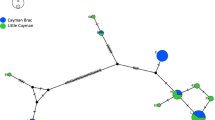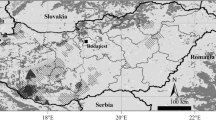Abstract
The Cook Islands endemic kakerori (Pomarea dimidiata) underwent a severe population decline following the introduction of ship rats (Rattus rattus) in the late 1800s. By 1989, the sole population on Rarotonga consisted of 29 known birds. Subsequent intensive management efforts enabled this population to recover to around 250–300 birds in recent years. This study, using microsatellite and mitochondrial DNA markers, assesses the level of genetic diversity and the genetic structure of the contemporary kakerori population on Rarotonga. No mitochondrial control region and cytochrome b haplotype diversity was found in the 11 samples examined at each locus. In 81 samples genotyped at 7 polymorphic microsatellite loci, an average of 4 alleles per locus were found, with an average observed heterozygosity of 0.65. No subpopulation division was found in this population. There was no evidence of inbreeding, but genetic bottleneck tests showed that the population had indeed experienced a significant genetic bottleneck. Recovery of the kakerori was successful in the past two decades despite low genetic diversity in terms of allelic diversity. Our data suggested that low allelic diversity did not hamper population expansion and the continued survival of this species, however, longer-term effects are still possible.



Similar content being viewed by others
References
Amos W, Balmford A (2001) When does conservation genetics matter? Heredity 87:257–265
Amos W, Harwood J (1998) Factors affecting levels of genetic diversity in natural populations. Phil Trans R Soc B 353:177–186
Ardern SL, Lambert DM (1997) Is the black robin in genetic peril? Mol Ecol 6:21–28
Beaumont MA, Zhang W, Balding DJ (2002) Approximate Bayesian computation in population genetics. Genetics 162:2025–2035
Chan C-H, Zhao Y, Cheung M-Y, Chambers GK (2008) Isolation and characterization of microsatellites in the kakerori (Pomarea dimidiata) using feathers as source of DNA. Conserv Genet 9:1067–1070
Cibois A, Thibault J-C, Pasquet E (2004) Biogeography of eastern Polynesian monarchs (Pomarea): an endemic genus close to extinction. Condor 106:837–851
Cornuet JM, Luikart G (1996) Description and power analysis of two tests for detecting recent population bottlenecks from allele frequency data. Genetics 144:2001–2014
Di Rienzo A, Peterson AC, Garza JC, Valdes AM, Slatkin M, Freimer NB (1994) Mutational processes of simple-sequence repeat loci in human populations. Proc Natl Acad Sci USA 91:3166–3170
Dieringer D, Schlötterer C (2002) MICORSATELLITE ANALYSER (MSA): a platform independent analysis tool for large microsatellite data sets. Mol Ecol Notes 3:167–169
England PR, Osler GHR, Woodworth LM, Montgomery ME, Briscoe DA, Frankham R (2003) Effects of intense versus diffuse population bottlenecks on microsatellite genetic diversity and evolutionary potential. Conserv Genet 4:595–604
Evans SR, Sheldon BC (2008) Interspecific patterns of genetic diversity in birds: correlations with extinction risk. Conserv Biol 22:1016–1025
Frankham R (1996) Relationship of genetic variation to population size in wildlife. Conserv Biol 10:1500–1508
Frankham R (1997) Do island populations have less genetic variation than mainland populations? Heredity 78:311–327
Frankham R (1998) Inbreeding and extinction: island populations. Conserv Biol 12:665–675
Guo SW, Thompson EA (1992) Performing the exact test of Hardy-Weinberg proportions for multiple alleles. Biometrics 48:361–372
Hansson B, Westerberg L (2002) On the correlation between heterozygosity and fitness in natural populations. Mol Ecol 11:2467–2474
Hoelzel AR, Fleischer RC, Campagna C, Le Boeuf BJ, Alvord G (2002) Impact of a population bottleneck on symmetry and genetic diversity in the northern elephant seal. J Evol Biol 15:567–575
Jamieson IG, Wallis GP, Briskie JV (2006) Inbreeding and endangered species management: is New Zealand out of step with the rest of the world? Conserv Biol 20:38–47
Kimura M, Crow JF (1964) The number of alleles that can be maintained in a finite population. Genetics 49:725–738
Lei R, Hu Z, Jiang Z, Yang W (2003) Phylogeography and genetic diversity of the critically endangered Przewalski’s gazelle. Anim Conserv 6:361–367
Meirmans PG, van Tienderen PH (2004) GENOTYPE and GENODIVE: two programs for the analysis of genetic diversity of asexual organisms. Mol Ecol Notes 4:792–794
Milot E, Weimerskirch H, Duchesne P, Bernatchez L (2007) Surviving with low genetic diversity: the case of albatrosses. Proc R Soc B 274:779–787
O’Brien SJ, Roelke ME, Marker L, Newman A, Winkler CA, Meltzer D, Colly L, Evermann JF, Bush M, Wildt DE (1985) Genetic basis for species vulnerability in the cheetah. Science 227:1428–1434
Ohta T, Kimura M (1973) A model of mutation appropriate to estimate the number of electrophoretic detectable alleles in a finite population. Genet Res 22:201–204
Pritchard JK, Stephens M, Donnelly P (2000) Inference of population structure using multilocus genotype data. Genetics 155:945–959
Raymond M, Rousset F (1995) GENEPOP (version 1.2): population genetic software for the exact tests and ecumenicisms. J Hered 86:248–249
Reed DH, Frankham R (2001) How closely correlated are molecular and quantitative measures of genetic variation? A meta-analysis. Evolution 55:1095–1103
Robertson HA, Hay JR, Saul EK, McCormack GV (1994) Recovery of the kakerori: an endangered forest bird of the Cook Islands. Conserv Biol 8:1078–1086
Robertson HA, Karika I, Saul EK (2006) Translocation of Rarotonga monarchs Pomarea dimidiata within the southern Cook Islands. Bird Conserv Int 16:197–215
Robertson HA, Karika I, Mateariki G, Nia L, Saul EK (2009) Long-term management of kakerori (Pomarea dimidiata) in the Cook Islands. DOC Research & Development Series 313. Department of Conservation, Wellington
Saccheri I, Kuussaari M, Kankare M, Vikman P, Fortelius W, Hanski I (1998) Inbreeding and extinction in a butterfly metapopulation. Nature 392:491–494
Saul EK, Robertson HA, Tiraa A (1998) Breeding biology of the kakerori (Pomarea dimidiata) on Rarotonga, Cook Islands. Notornis 45:255–269
Spielman D, Brook BW, Briscoe DA, Frankham R (2004) Does inbreeding and loss of genetic diversity decrease disease resistance? Conserv Genet 5:439–448
Tallmon DA, Luikart G, Beaumont MA (2004) Comparative evaluation of a new effective population size estimator based on approximate Bayesian computation. Genetics 167:977–988
Tallmon DA, Koyuk A, Luikart G, Beaumont MA (2008) ONeSAMP: a program to estimate effective population size using approximate Bayesian computation. Mol Ecol Resources 8:299–301
Tarr CL (1995) Primers for amplification and determination of mitochondrial control-region sequences in oscine passerines. Mol Ecol 4:527–529
Thibault J-C, Martin J-L, Penloup A, Meyer J-Y (2002) Understanding the decline and extinction of monarchs (Aves) in Polynesian islands. Biol Conserv 108:161–174
Weir BS, Cockerham CC (1984) Estimating F-statistics for the analysis of population structure. Evolution 38:1358–1370
Acknowledgments
This work is supported by the University Research Fund 26151/1469 of Victoria University of Wellington, the Takitumu Conservation Area Project, and the New Zealand Department of Conservation. The kakerori recovery programme and Takitumu Conservation Area Project has been supported over the years by the Avifauna Conservation Programme of the South Pacific Regional Environment Programme, New Zealand Agency for International Development (NZAID), the Pacific Conservation and Development Trust, the South Pacific Biodiversity Conservation Programme, the Pacific Initiatives for the Environment (NZAID), the Disney Wildlife Conservation Foundation, the Swedish Club of 300, and the Global Environment Facility. We would like to thank Ian Karika and many conservation volunteers for field support, and two anonymous reviewers for their comments and suggestions in improving this manuscript.
Author information
Authors and Affiliations
Corresponding author
Rights and permissions
About this article
Cite this article
Chan, CH., Robertson, H.A., Saul, E.K. et al. Genetic variation in the kakerori (Pomarea dimidiata), an endangered endemic bird successfully recovering in the Cook Islands. Conserv Genet 12, 441–447 (2011). https://doi.org/10.1007/s10592-010-0152-2
Received:
Accepted:
Published:
Issue Date:
DOI: https://doi.org/10.1007/s10592-010-0152-2




